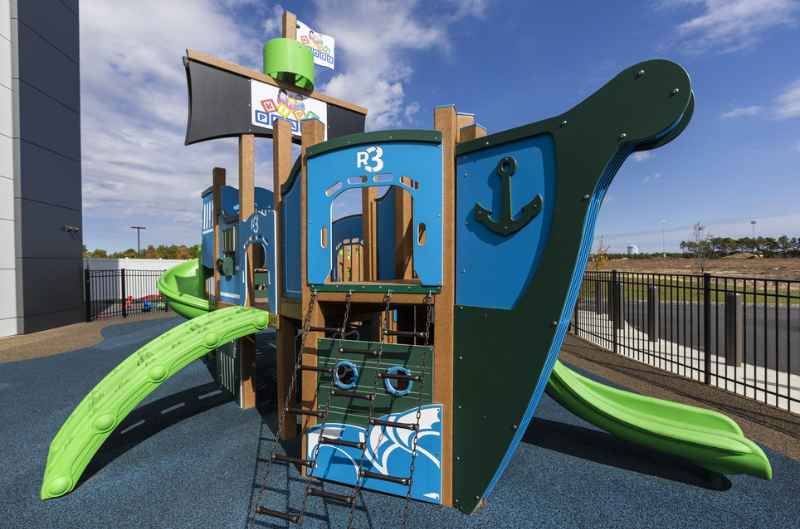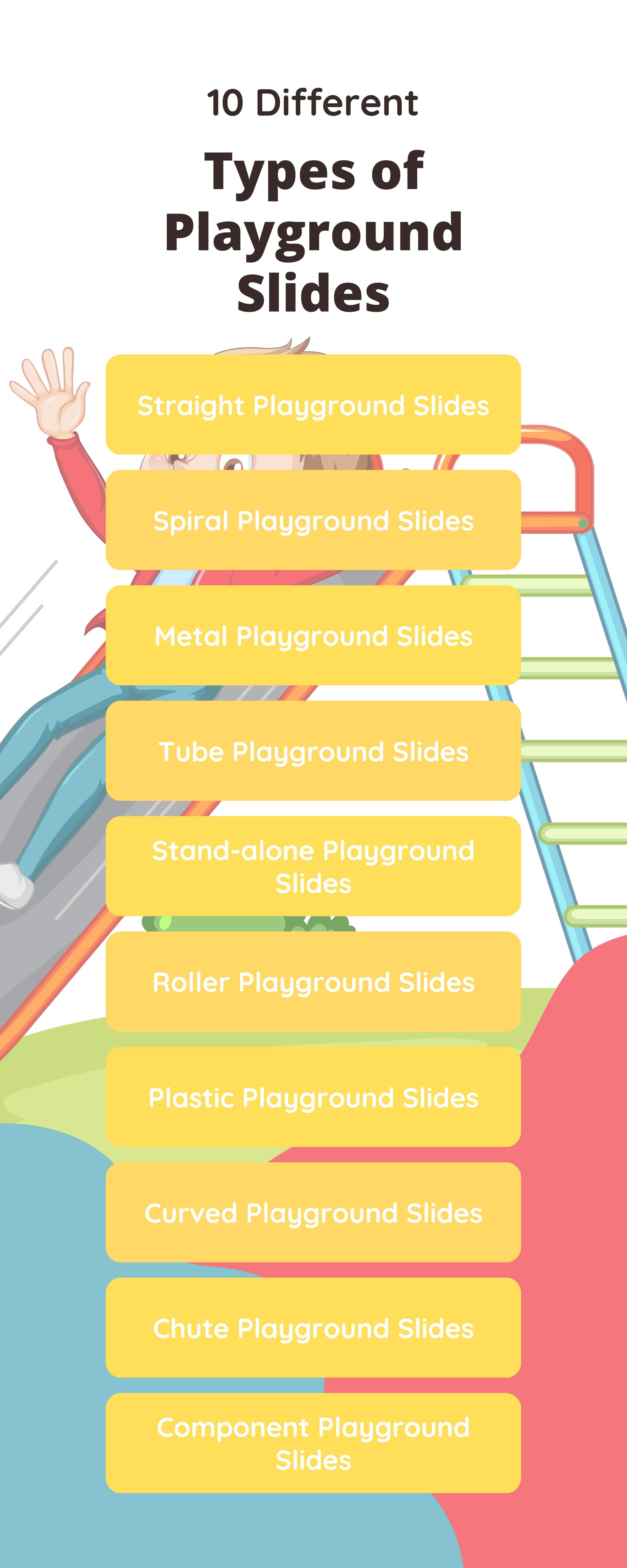
10 Best Innovative Types of Playground Slides
|
|
Author: Austin Stanfel
Do you own a playground? Are you considering installing playground slides to increase your children’s enjoyment? Need help choosing the right one? Then, let us help you.
When children visit a playground, they are often most thrilled by a colorful slide that provides an adrenaline rush. It is a common sight in commercial playgrounds and is usually one of the first play items children want to try.
Whether you are building a new playground or are searching for ways to add thrills to an existing playground, Slides are the first answer that comes to mind. However, how does one choose the best option among hundreds of options and varieties available?
Fortunately, we have compiled a list of the ten best innovative types of playground slides. These are differentiated by their structure, material, or even the cost of putting them in the playground.
How to Choose the Right Playground Slide?
Choosing the proper playground slide is critical because it ensures the safety of the children who use the playground equipment. Here are a few things to consider before selecting slides for the playground
Material
Steel, plastic, and fiberglass are the three major components of a playground slide. Steel is an iconic material for creating durable playground slides because it is long-lasting and slippery. Plastic-made slides are an alternative. These are typically found in high-end organizations and water parks due to their high cost.
Size
Slides for playgrounds can be purchased in various heights and widths to provide a wide range of play experiences. The age group and the free space for a slide will determine the appropriate size for a playground slide. Taller slides, for example, are better suited to school-aged children, whereas smaller slides are better suited to young children.
Safety
Not all playground slides are appropriate for small children. Before choosing slides, you should consider the “use zone,” which relates to the desired requirements around playground equipment. It ensures the safety of the playground’s users by providing sufficient space for them to even play around the equipment.
Colors
The playground’s colors are essential to keep in mind before choosing your slide because it adds to the fun and excitement. There are various color options for slides, allowing you to select a color that will appeal to children while complementing the other pieces of playground equipment.
Top 10 Different Types of Playground Slides
Here are ten different types of playground slides, which differ in shape, material, and construction.
1. Straight Playground Slides
This is the most common playground slide type and can be found in most playgrounds. The chute descends in a horizontal path at an angle and does not turn, curve, or wave.
The chute angle is entirely determined by the age group for which the slide is intended. The average inclination for toddlers is up to 24 degrees, while for school-aged children, it is no more than 30 degrees.
2. Spiral Playground Slides
Spiral slides are the second on our list. It rotates more than 360 degrees as it descends around a center. Children enjoy this because they can move quickly and have no idea where they are going until they reach the bottom.
Spiral slides for toddlers and preschool-aged children should be relatively short, with no more than one 360-degree spin. This is due to this age group’s immature balance and postural control.
3. Metal Playground Slides
Metal is one material that could be used to make a playground slide. These metal playground slides are commonly made of stainless steel or anodized aluminum. The strength of stainless-steel slides allows them for usage in unusual ways, such as wide slides.
Sandblasting is done on metal to give these slides a smooth surface. On hot days, this metal is further treated with an epoxy coating or powdered paint to lower the temperature over the surface. Although they are more expensive than plastic slides, they are faster, making them more enjoyable for children.
4. Tube Playground Slides
Tube Slides are slides that have complete sections sealed as a tube. They can be horizontal, rounded, or a combination of the two. Because of their extra level of structure, they can withstand weight levels that other slides cannot.
Tube slides add a layer of security, enabling longer and bigger uses, and thus are enjoyable for the entire family. Some barriers stop children from reaching the top of or sliding onto the outside of the tube to improve safety.
5. Stand-alone Playground Slides
A stand-alone slide is not connected to any other portion of playgrounds. It is necessary to gain access to the slide’s platform. It could be a ladder or a flight of stairs.
You get visibility from everywhere with stand-alone slides. However, there are fewer play opportunities for the size of the space required to set it up.
6. Roller Playground Slides
Roller slides are those slides that look like they belong on an airport conveyor belt. They are constructed of numerous parallel cylindrical rollers, eliminating the trouble of children getting stuck halfway down the slide.
Furthermore, these slides provide a new tactile physical sensation, which can be soothing for children who have difficulties processing their senses.
7. Plastic Playground Slides
Plastic playground slides are a popular option for smaller slides. They are less expensive, easier to clean, and can be recycled into new ones. The most significant advantage of plastic slides is that they can be customized to have curvatures and bends to provide a fun experience for children.
The most popular plastic used for slide production is high-density polyethylene or HDPE. They are occasionally made of low-density polyethylene, but HDPE is the more rigid and sturdy option.
8. Curved Playground Slides
The primary distinction between straight and curved playground slides is that curved slides have more twists and turns. This adds to the fun and excitement.
These slides are offered in two basic shapes: L-Shaped and J-Shaped. The L-Shaped slides flip at a 90-degree angle, whereas the J-Shaped slides turn at a 180-degree angle. Aside from these two options, the curved slides are also accessible in a back-and-forth pattern.
9. Chute Playground Slides
Open chute slides are the most common type of chute slide. They enable the slider to see the world around them while allowing anyone nearby to witness the action. This is useful for parents or guardians who want to keep an eye on their children.
They can also be easily modified because the chute pieces are adjustable and are made to fit the desired shape. These slides are also perfect for use where an open slide feel is desired. Still, the entrance and top of the slide are brilliantly designed as a tunnel to prevent the entry of skateboarders and bikes.
10. Component Playground Slides
The last item on our list of playground slides is a component slide that is a part of a more considerable structure, like a jungle gym. Instead of having a ladder or stairway connected directly to the slide, children typically gain access to it through another portion of the structure.
The upside of a component slide is that it keeps children amused for extended periods because it is combined with other features, such as swings and monkey bars.
Why Should You Have Slides in Your Playground?
Slides are a must-have in any playground for a variety of reasons. Some children enjoy the wonder of covered tube slides, while others love the rush of a sleek, straight slide. They are quick ways for kids to enjoy a playground, so they are worth using repeatedly.
Furthermore, other playground equipment may require additional effort before the fun begins. Swings, for example, require a few minutes of building momentum before reaching a thrilling height.
Slides provide children with an engaging structure but also have other features such as: –
• Encourage Balance and Coordination: When a child moves up a slide and then satisfactorily position and pushes themselves into the chute, they develop essential balance and coordination skills. It also assists children in developing situational awareness because they must judge when it is safe to slide and when it is safe to put their feet down once they reach the bottom of the slides.
• Provide Healthy Physical Challenges: : Children develop upper and lower body strength as they climb up and step up the rungs of the ladder of playground slides. This gives increased strength, regular cardiovascular exercise, and the maintenance and growth of lean muscle.
• Promote Positive Social Skill Development: When kids play around each other, the slide is a great way to promote crucial social skills like group activities, communicating, taking turns, and learning patience and tolerance of others’ abilities. These abilities will have a long-term impact on their social interactions as they grow.
Final Thoughts
Playground slides are a classic playground staple and can be built using a variety of approaches. They are both enjoyable and helpful to young children’s development. We understand this at Creative Recreational Systems, Inc.
We are an industry-leading manufacturer of outdoor play equipment thanks to our legacy of innovative leadership, a bold strategy, and research-based inclusive design. Contact us today to get the perfect playground equipment for the playground.



